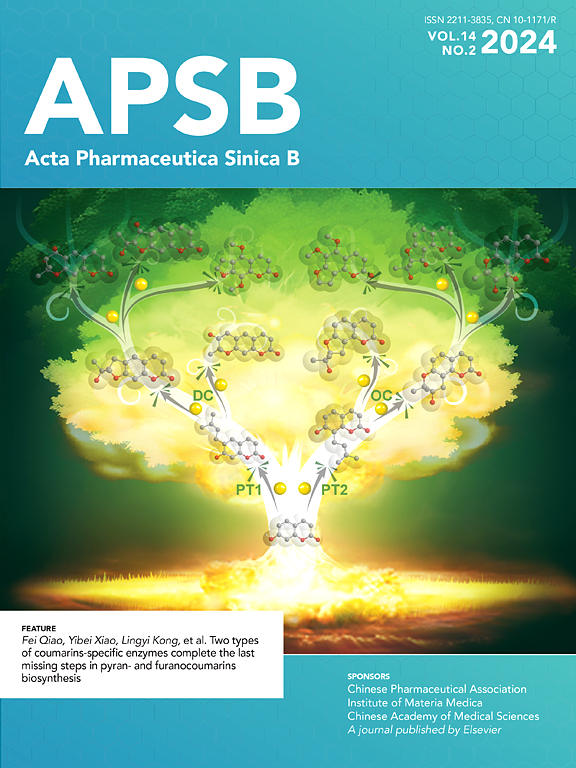Enhanced BBB penetration and microglia-targeting nanomodulator for the two-pronged modulation of chronically activated microglia-mediated neuroinflammation in Alzheimer's disease
IF 14.7
1区 医学
Q1 PHARMACOLOGY & PHARMACY
引用次数: 0
Abstract
Intervention in chronically activated microglia-mediated neuroinflammation is a novel approach to treat Alzheimer's disease (AD). The low permeability of the blood‒brain barrier (BBB) and non-selective distribution in the brain severely restrict AD drugs' disease-modifying efficacy. Here, an immunosuppressant TREM2-lowing antisense oligonucleotides (ASOs) and resveratrol co-loaded cationic liposome is developed as an immune reprogramming nanomodulator modified by acid-cleavable BBB-targeting peptide and microglia-targeting peptide (Res@TcMNP/ASO) for AD management. Res@TcMNP/ASO can enter brain endothelial cells via D-T7 peptides. Then D-T7 undergoes an acid-responsive cleavage, facilitating the escape of Res@MNP/ASO from endo/lysosomes to cross the BBB. The detached Res@MNP/ASO specifically targets M1-phenotype microglia via exposed MG1 peptides to prompt the simultaneous delivery of two drugs into activated microglia. This nanomodulator can not only restore the immune function of microglia through TREM2-lowing ASO but also mitigate the immune stimulation to microglia caused by reactive oxygen species (ROS) through resveratrol, thereby synergistically inhibiting the chronic activation of microglia to alleviate neuroinflammation in AD. Our results indicate that this combination treatment can achieve significant behavioral and cognitive improvements in late APP/PS1 mice.

干预长期激活的小胶质细胞介导的神经炎症是治疗阿尔茨海默病(AD)的一种新方法。血脑屏障(BBB)的低通透性和在大脑中的非选择性分布严重限制了治疗阿尔茨海默病药物的疗效。在这里,我们开发了一种免疫抑制剂TREM2-lowing反义寡核苷酸(ASOs)和白藜芦醇共同负载的阳离子脂质体,作为一种免疫重编程纳米调节剂,由可酸解的BBB靶向肽和小胶质细胞靶向肽修饰(Res@TcMNP/ASO),用于治疗AD。Res@TcMNP/ASO 可通过 D-T7 肽进入脑内皮细胞。然后,D-T7发生酸反应裂解,促进Res@MNP/ASO从内/溶酶体中脱落,穿过BBB。脱落的 Res@MNP/ASO 通过暴露的 MG1 肽特异性地靶向 M1 表型小胶质细胞,促使两种药物同时进入活化的小胶质细胞。这种纳米调节剂不仅能通过TREM2-lowing ASO恢复小胶质细胞的免疫功能,还能通过白藜芦醇减轻活性氧(ROS)对小胶质细胞的免疫刺激,从而协同抑制小胶质细胞的慢性激活,缓解AD的神经炎症。我们的研究结果表明,这种联合疗法可以显著改善晚期APP/PS1小鼠的行为和认知能力。
本文章由计算机程序翻译,如有差异,请以英文原文为准。
求助全文
约1分钟内获得全文
求助全文
来源期刊

Acta Pharmaceutica Sinica. B
Pharmacology, Toxicology and Pharmaceutics-General Pharmacology, Toxicology and Pharmaceutics
CiteScore
22.40
自引率
5.50%
发文量
1051
审稿时长
19 weeks
期刊介绍:
The Journal of the Institute of Materia Medica, Chinese Academy of Medical Sciences, and the Chinese Pharmaceutical Association oversees the peer review process for Acta Pharmaceutica Sinica. B (APSB).
Published monthly in English, APSB is dedicated to disseminating significant original research articles, rapid communications, and high-quality reviews that highlight recent advances across various pharmaceutical sciences domains. These encompass pharmacology, pharmaceutics, medicinal chemistry, natural products, pharmacognosy, pharmaceutical analysis, and pharmacokinetics.
A part of the Acta Pharmaceutica Sinica series, established in 1953 and indexed in prominent databases like Chemical Abstracts, Index Medicus, SciFinder Scholar, Biological Abstracts, International Pharmaceutical Abstracts, Cambridge Scientific Abstracts, and Current Bibliography on Science and Technology, APSB is sponsored by the Institute of Materia Medica, Chinese Academy of Medical Sciences, and the Chinese Pharmaceutical Association. Its production and hosting are facilitated by Elsevier B.V. This collaborative effort ensures APSB's commitment to delivering valuable contributions to the pharmaceutical sciences community.
 求助内容:
求助内容: 应助结果提醒方式:
应助结果提醒方式:


